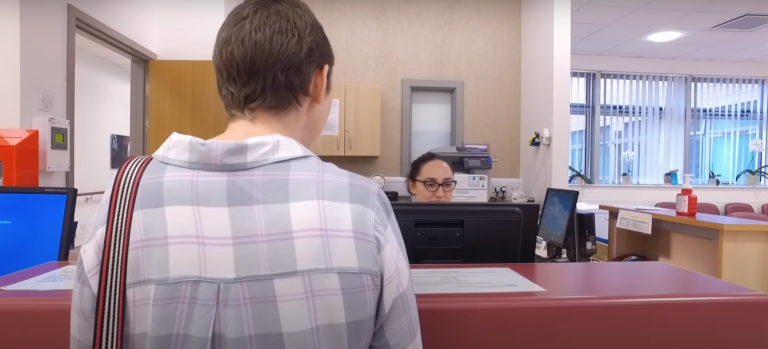Testicular cancer: symptoms, early detection, treatment
Testicular cancer: symptoms, early detection, treatment
Testicular cancer is the most common malignant tumor disease in men between the ages of 25 and 45. It is generally well treatable. Therefore most patients can be cured. In order to detect testicular cancer at an early stage, all men should regularly palpate their testicles from puberty onwards. Here you can find out everything you need to know about the topic: How can testicular cancer be detected? What causes it? What treatment options are available? What are the chances of cure for testicular cancer?

Brief overview
- What is testicular cancer? Malignant tumor of the testicular tissue. Usually only one testicle is affected. The most frequent forms of testicular cancer are so-called seminomas, followed by non-seminomas.
- Frequency: Most common cancer in men between 25 and 45 years of age (average age of patients: 38 years) – testicular cancer accounts for 20 to 30 percent of all cancers in this age group. Younger and older men fall ill much less frequently. Overall, testicular cancer is a rare cancer.
- Symptoms: palpable, painless hardening within the scrotum, enlarged testicles (with a feeling of heaviness), enlarged, painful breasts, in advanced stages additional symptoms due to daughter tumours (metastases) such as coughing and chest pain with lung metastases
- Treatment: Removal of the affected testis; then, depending on the stage of the tumour and the type of testicular cancer, monitoring strategy (“wait and see”), chemotherapy or radiotherapy; possibly removal of affected lymph nodes
- Prognosis: Testicular cancer is generally very well treatable. Most patients can be cured.
Testicular cancer: symptoms & early detection
The same applies to testicular cancer (testicular carcinoma) as to other types of cancer: the earlier the malignant tumour is discovered and treated, the better the chances of recovery. But how do you recognize testicular cancer?
Palpable hardening
One of the most common symptoms of testicular cancer is a painless hardening within the scrotum: the surface of the testicle feels knotty or bumpy. Every man can feel a hard lump in the testicles (possibly testicular cancer) if he regularly examines himself. It is important to compare the altered testis with the second testis. This is because differences are easier to identify.
In about 95 percent of all cases, testicular cancer affects only one of the two testicles. In the remaining five percent of patients, cancer cells develop in both testicles.
Increase in size and feeling of heaviness
If a testicle becomes enlarged, this is also a possible sign of testicular cancer. Most patients report this symptom when they go to the doctor for the first time. This increase in size can be caused by the tumor growth itself. On the other hand, the reason may be an accumulation of fluid (hydrocele or water breakage).
Due to the increase in size the affected testicle feels heavy. This feeling of heaviness is accompanied in some patients by a pulling sensation that can radiate into the groin.
Pain
In some patients, pain in the testicular area is another testicular cancer symptom. Bleeding within the cancerous tissue can cause a sting or squeeze. However, pain is rarely the first sign of testicular cancer.
If there is pain in the area of the testicles, one should not immediately think of testicular cancer! Usually an inflammation of the testicles (orchitis) or epididymitis is behind it. An examination by a urologist provides certainty.
In advanced testicular cancer, the lymph nodes in the posterior abdomen enlarge. This can cause back pain.
Breast Growth
Some testicular tumors produce female hormones. For example, elevated estrogen levels in the blood of some patients can be detected. The pregnancy hormone beta-human chorionic gonadotropin (β-HCG) is also produced by some testicular tumors. As a result of hormone production, the man’s breast enlarges (on one or both sides). Doctors call this testicular cancer symptom a real gynecomastia, because the glandular tissue in the breast actually multiplies here. In contrast, fake gynecomastia describes breast growth through fat storage.
The β-HCG is also considered an important tumor marker. This is a blood value that is typical for some testicular carcinomas. It helps to diagnose testicular cancer and assess the course of the disease.
The enlarged breasts can also be painful.
Symptoms due to cancer metastases
If testicular cancer progresses further, cancer cells can spread throughout the body via lymphatic and blood vessels and form new tumours somewhere. Such metastases of testicular cancer occur mainly in the lungs. However, other organs can also be affected, such as the brain, bones and liver. Depending on the organ affected, corresponding complaints occur.
For example, pulmonary metastases often cause coughing (sometimes with bloody sputum) and shortness of breath. Chest pain is then also a common symptom. Testicular cancer metastases in the bones cause bone pain. Liver metastases can become noticeable in a short time through nausea, loss of appetite and unwanted weight loss, among other things. If cancer cells spread in the brain, neurological failures can be added to the common signs of testicular cancer.
If you discover something, for example a lump, if something tweaks, pinches or if the testicle is somehow swollen, then go to the doctor. I have noticed that young men nowadays pay much more attention to themselves than was previously the case. That someone comes to us with a testicular tumor of almost ball size is the absolute exception.
Usually, yes. The diseased testicle must be removed. But with the remaining one you can usually live well. For young men who have not yet completed family planning, we recommend freezing a sperm sample. If you want, you can also have a testicular prosthesis inserted for cosmetic reasons.
Often testicular cancer is discovered so early that patients do not even need chemotherapy. Although the testicle must be removed and the lymph nodes examined. Aftercare programmes are also important. But then the prospect of life returning to normal is very high.
Testicular cancer: treatment
In principle, the following treatment measures are available for testicular cancer therapy:
- Operation
- Surveillance strategy: “wait and see”
- Radiotherapy (irradiation)
- Chemotherapy
The attending physician will suggest an individually adapted therapy plan to a testicular cancer patient.
The first step of testicular cancer treatment is usually surgery. The further treatment steps depend on the stage of the disease and the type of tumour (seminoma or non-seminoma – by far the most common forms of testicular cancer).
Testicular cancer: Surgery
In testicular cancer surgery, the affected testicle, its epididymis and the spermatic cord are surgically removed. Doctors speak of the ablatio testis or orchiectomy. In a few cases, testicular cancer can also be operated on in such a way that part of the testicle is preserved. This can then continue to produce hormones. This procedure is particularly useful for patients who only have one testicle. To be on the safe side, the operated testicle usually has to be irradiated afterwards.
At the patient’s request, a granule-sized tissue sample can also be taken from the other testicle during the procedure and immediately examined under the microscope. This is advisable because in about five percent of patients pathologically altered cells are also found in the second testis. In this case this testicle can be removed at the same time.
The removed testicle can be replaced by a prosthesis at the patient’s request. For this purpose, a silicone cushion of suitable size and shape is inserted into the remaining scrotum. If chemotherapy is still necessary after the testicle removal, the insertion of the testicular prosthesis will be delayed.
Tumor stages
The removed testicular cancer tissue is examined in a fine tissue examination. Together with other examinations (such as computer tomography), the stage of the disease can be determined (see below: examinations and diagnosis). The following tumor stages are roughly distinguished:
- Stage I: malignant tumour only in the testicles, no metastases.
- Stage II: Infection of neighbouring (regional) lymph nodes, but no cancerous metastases further away (distant metastases); depending on the size or number of affected lymph nodes, stage II is further subdivided (IIA, IIB, IIC)
- Stage III: distant metastases are also present (e.g. in the lungs); further subdivision according to severity (IIIA, IIIB, IIIC)
Testicular Seminoma
The most common form of testicular cancer is the seminoma. In the early stages (stage I), further treatment after testicle removal is often limited to the monitoring strategy: the patient must undergo regular thorough examinations to see whether the cancer may have returned. In the initial period, these check-ups will be very close meshed. Later on, the time intervals between them can be increased.
However, to improve the prognosis, a seminoma can also be treated with chemo- or radiotherapy at an early stage after surgery. If the seminoma is already more advanced at the time of testicle removal, patients receive either chemotherapy or radiotherapy after the procedure on all precipitates. Which form of therapy is the best option in an individual case depends, among other things, on the exact stage of the tumour.
In principle, it is also possible to combine radiation and chemotherapy. However, this therapy variant is currently only being tested in clinical studies at a seminar.
You can read more about the treatment of seminoma and other important information about this most common form of testicular cancer in the article Seminom.
Non-Seminoma
Non-seminomas are the second most common type of testicular cancer after seminomas. Here, too, the treatment steps after testicle removal depend on the stage of the tumour, as follows:
Testicular Cancer Stages
Testicular cancer stage I
At this early stage, in non-seminar (as in seminoma) after testicle removal, the monitoring strategy is usually sufficient: With the help of regular check-ups, possible relapses can be detected and treated early on.
By definition, stage I testicular cancer is limited to the testicles and has not yet spread to lymph nodes or other parts of the body. However, despite modern imaging techniques such as computer tomography, this cannot be said with 100 percent certainty. Sometimes cancer metastases are so small that they are not detected by imaging. Two factors can indicate such non-visible (occult) metastases:
- When examining the removed tumor tissue, one finds that the testicular cancer has invaded adjacent lymphatic or blood vessels. The risk of occult metastases then increases to about fifty percent.
- After tumour removal, the respective tumour markers in the blood do not drop or even rise.
In such cases there is therefore an increased risk that the testicular cancer has already spread. For safety reasons, chemotherapy (1 cycle) rather than a monitoring strategy is recommended after the testicle removal: Patients are administered three chemotherapeutic drugs over several days: cisplatin, etoposide and bleomycin (collectively known as PEB). It may also be advisable to remove the lymph nodes in the back of the abdomen (lymphadenectomy). The person concerned is then closely monitored and controlled.
Testicular cancer stages IIA and IIB
In these two stages of testicular cancer lymph nodes are already affected and thus enlarged. Then there are two options for further treatment after the testicle removal:
- Either the affected lymph nodes are surgically removed, possibly followed by chemotherapy (if individual cancer cells remain in the body).
- Or the patient receives three cycles of chemotherapy immediately after the testicular surgery. Afterwards, any lymph nodes still affected can be surgically removed.
Testicular cancer stages IIC and III
In these advanced non-seminoma stages, patients are treated with three to four cycles of chemotherapy after testicle removal. If affected lymph nodes are still present afterwards, they are removed (lymphadenectomy).
Side effects of testicular cancer therapy
Chemotherapy for testicular cancer (and other forms of cancer) can have various side effects: The drugs (cytostatics) administered in this process are very toxic for cells – not only for testicular cancer cells, but also for healthy body cells such as blood platelets, blood cells and hair root cells. Possible side effects are therefore, for example, anaemia, bleeding, hair loss, nausea and vomiting, loss of appetite, inflammation of the mucous membranes, hearing disorders and sensations in the hands and feet. Cytostatic drugs also attack the immune system. Patients are therefore more susceptible to pathogens during treatment.
As a rule, these side effects disappear again after completion of chemotherapy. In addition, doctors can help with suitable measures and tips to alleviate the undesirable effects of the treatment (for example, with anti-nausea medication).
In the case of a (suspected) lymph node infection in the posterior abdomen, this region is often treated with radiotherapy. The most common side effect is slight nausea. It occurs a few hours after irradiation and can be alleviated with medication. Other possible side effects are temporary diarrhoea as well as skin irritation in the irradiated area (such as redness, itching).
Testicular cancer: causes and risk factors
Testicular cancer (testicular carcinoma) in adult men arises in over 90 percent of cases from the germ cells in the testicles. They are called germ cell tumors (germinal tumors). The small remainder are the non-terminal tumours. They arise from the supporting and connective tissue of the testis.
Germ cell tumours: seminomas and non-seminomas
Germ cell tumours are divided into two main groups: seminomas and non-seminomas.
A seminoma develops from abnormal stem cells of spermatogonia. It is the most common form of malignant germ cell tumor in the testis. The average age of the patients is around 40 years.
With the particularly frequent seminoma degenerate germ cells in the testicular tissue. They are often externally palpable as firm knots.
The term non-seminoma covers all other germinal forms of testicular cancer that arise from other tissue types. It’s part of the deal:
- Yolk sac tumor
- Chorionic carcinoma
- embryonal carcinoma
- Teratoma or the malignant form teratocarcinoma
Patients with a non-seminoma are on average 25 years old.
The preliminary stage of seminomas and non-seminomas is called testicular intraepithelial neoplasia (TIN) (intraepithelial = located within the covering tissue, neoplasia = new formation). The new formations arise from embryonic germ cells even before birth. They rest in the testicles and can later develop into testicular cancer.
Non-terminal tumours
Much rarer than the germ cell tumours are the non-terminal tumours (germinal strand tumours, gonadal stroma tumours). These are cell proliferations that arise from supporting and connective tissue cells of the testis. They are either benign or malignant. The most important representative of the malignant germ line tumours is the Leydig cell testicular cancer. It emerges from the Leydig cells. They produce the sex hormone testosterone and thus stimulate sperm production, among other things.
Non-terminal tumours are mainly found in children. They are very rare in adult males (most likely at an advanced age).
Why does testicular cancer develop?
The exact cause of testicular cancer is not yet known. However, researchers have in the past identified some risk factors for its development.
Past testicular cancer
An earlier testicular cancer is the most important risk factor: Those who have already had testicular cancer once have a 30-fold increased risk of developing a malignant testicular tumor again.
Undescended testicle
Normally the two testicles migrate from the abdominal cavity into the scrotum during the development of the foetus (sometimes only after birth). In case of an undescended testicle (maldescensus testis), however, one of the testicles remains or both testicles remain either in the abdominal cavity or in the groin (abdominal or inguinal testicles). Sometimes the testicle is located at the entrance of the testicle and can be pushed into the scrotum under pressure, but it slides back immediately. Then one speaks of sliding testicles.
An undescended testicle increases the probability of developing testicular cancer. This danger still exists even if the undescended testicle has been surgically removed: For example, the risk of testicular cancer is 2.75 to 8 times higher when the testicle is elevated during surgery than when it is normal. Especially in the case of the sliding testis, the risk of degeneration depends on the duration of the malposition. Above the scrotum, the body temperature of 35 to 37 degrees Celsius is significantly higher than in the scrotum (about 33 degrees Celsius). The higher temperature can damage the testicular tissue. Therefore, the risk of testicular cancer is increased with (previous) undescended testicles.
Urethral orifice malformation
If the orifice of the urethra is below the glans (i.e. on the underside of the penis), doctors speak of hypospadias. Studies suggest that the risk of testicular cancer is increased due to this disposition.
Hypospadias and undescended testicles seem to have a similar genetic cause. They therefore often appear together. However, they can also appear separately.
Genetic factors
According to studies, hereditary factors most likely also influence the development of testicular carcinoma. This is because the same tumour occurs more frequently in some families. Brothers of affected persons have an up to twelve times higher risk of also developing testicular cancer. Statistically speaking, sons of sick fathers also develop testicular carcinoma more often than sons of healthy fathers.
It has also been found that testicular cancer is much more common in fair-skinned European men than in African men.
Oestrogen excess in pregnancy
By far the most common form of testicular cancer (germ cell tumours) develops from a preliminary stage called TIN (testicular intraepithelial neoplasia). It is based on germ cells that develop incorrectly in the embryo even before birth. One of the reasons for this is considered to be a hormone imbalance during pregnancy, more precisely: an excess of female hormones (estrogens). This can very likely disturb the testicular development of the unborn child and lead to the precancerous stage TIN.
A slight oestrogen surplus is observed, for example, in pregnant women who are expecting their first child or twins or who are over 30 years old. Taking medication containing estrogens can also cause hormone levels to rise in pregnant women. However, nowadays pregnant women are hardly ever treated with hormones.
Infertility
The risk of testicular cancer is also increased in a man who is sterile. Infertility is either due to underdeveloped testicles (hypogonadism) or to a lack or total absence of sperm in the seminal fluid (oligospermia or azoospermia).
The causes of infertility can be different. Sometimes it is the result of testicular inflammation (orchitis) caused by the mumps virus. Deviations (anomalies) in the genetic material can also make men infertile, for example Klinefelter’s syndrome.
Outside influences
Worldwide, the number of testicular cancer cases has increased significantly in the last 20 years. Experts therefore suspect that external influences in childhood and early adulthood also favour the development of cancer. But this needs to be researched in more detail.
Testicular cancer: diagnosis and examination
Men should regularly examine and palpate their testicles themselves, especially between the ages of 20 and 40. Anyone who notices a change within the scrotum should quickly consult a urologist. This specialist for urinary and genital organs can clarify the suspicion of testicular cancer by means of some examinations.
Doctor-patient consultation
At first, the doctor will talk to the patient in detail in order to establish the patient’s medical history (anamnesis). The doctor will ask for any complaints that may occur, for example:
- Have you noticed a hardening in the scrotum?
- Do you feel any heaviness or even pain in the area in question?
- Have you noticed any other changes in you, such as an increase in breast size?
During the consultation the doctor will also clarify possible risk factors: Have you had a testicular tumor in the past? Did you have an undescended testicle? Has anyone in your family had testicular cancer? Every piece of information is important, even those that seem rather insignificant to the patient himself. For example, swelling in the groin, back pain or coughing can indicate cancerous metastases and thus advanced testicular cancer.
Palpate the testicles
The medical history interview is followed by a physical examination. Especially the bimanual examination of the testicles is important. The doctor holds the testicle with one hand while palpating it with the other for irregularities. In this way both testicles are carefully examined, even if only one shows suspicious changes. The side comparison can provide important information (testicular cancer usually affects only one testicle alone). The following applies to the palpation examination: Any enlargement or hardening in or on the testis is suspected of being tumorous.
Tip: Every man should regularly palpate his testicles himself. This allows him to detect suspicious changes early on and to consult a doctor. If it really is testicular cancer, an early diagnosis improves the chances of recovery!
How to proceed with the self-examination of the testis is explained in the article Scanning the testis.
Palpation of the breast
During the physical examination, the doctor will also palpate the man’s breast if testicular cancer is suspected. The female hormones produced by a testicular tumor cause the mammary glands to swell painfully.
Ultrasound
The ultrasound examination to clarify testicular cancer is performed with a high-resolution transducer. Typical are irregular areas that appear darker than the surrounding tissue. Smaller and non-palpable testicular cancer foci can also be detected by ultrasound. The examination is carried out on both testicles in order to rule out the possibility of bilateral infection.
Blood test
If testicular cancer is suspected, a comprehensive blood test is also important. On the one hand, the physician gains information about the general condition of the patient and the function of individual organs. On the other hand, so-called tumour markers are determined in the blood. These are proteins that are either only detectable in cancer or are produced in strikingly increased quantities in cancer patients.
One such tumor marker in testicular cancer is alpha-fetoprotein (AFP). This protein is produced during pregnancy in the yolk sac of an unborn child. In adults it is only produced in very small amounts by liver and intestinal cells. If a man has an elevated AFP level, this indicates testicular cancer – especially certain forms of non-seminomas (yolk sac tumor and embryonic carcinoma). In a seminoma, however, the AFP value is normal.
Another important tumor marker in testicular cancer is beta-human chorionic gonadotropin (β-HCG). Its value is particularly elevated in the case of chorionic carcinoma (a form of non-seminoma), whereas in the case of a seminoma it is elevated in only about 20 percent of all cases.
Lactate dehydrogenase (LDH) is an enzyme that also occurs in many body cells. In testicular cancer it is only suitable as a complementary tumour marker (besides AFP and β-HCG).
The blood level of placental alkaline phosphatase (PLAP) is particularly elevated in a seminoma. However, since the value is also elevated in almost all smokers, PLAP is only suitable to a very limited extent as a tumor marker for testicular cancer.
These tumor markers are not elevated in every testicular cancer patient. Conversely, healthy people may also show elevated values under certain circumstances. The tumour markers alone do not therefore allow a reliable diagnosis. However, they are suitable for assessing the course of testicular cancer. If, for example, the tumour markers rise again after a completed treatment, this can signal a relapse (recurrence).
CT and MRT
Once a testicular cancer diagnosis has been made, computer tomography (CT) provides information about the spread of the tumor: detailed cross-sectional images of the pelvic, abdominal and thoracic areas and possibly the head are taken with the help of X-rays. Enlarged lymph nodes and testicular cancer metastases (metastases of the tumor in other parts of the body) are generally easy to detect. As a rule, the patient is injected with a contrast medium before the examination to improve imaging.
An alternative to CT is magnetic resonance imaging (MRI): it also provides detailed sectional images of the inside of the body, but using magnetic fields (and not X-rays). The patient is therefore not exposed to radiation. An MRI is performed, for example, if the patient is allergic to the contrast medium that should be used in the CT.
Testicular excavation
In order to confirm a testicular cancer diagnosis, the suspected testicle is surgically exposed. The doctor can then usually see with the naked eye whether a malignant testicular tumour is actually present. In case of doubt, he takes a tissue sample that is examined for cancer cells during the operation. If so, it will be checked whether it is a seminoma or a non-seminoma. In case of testicular cancer, the affected testicle is removed immediately.
Testicular cancer: course of disease and prognosis
As a rule, testicular cancer can be well treated and usually cured. Five years after a testicular cancer diagnosis still about 96 percent of patients (5-year survival rate).
This good prognosis is mainly due to the fact that in most patients testicular carcinoma is detected at an early stage. The chances of success of the treatment are then high. However, if the cancer has already spread further at the time of diagnosis, the chances of recovery are reduced. However, the prognosis in individual cases is also influenced, for example, by the fact that
- what type of tumour is present (seminomas generally have a more favourable prognosis than non-seminomas)
- how well the patient responds to the therapy
- where metastases have already formed in the body (the prognosis is usually better for lymph node and lung metastases than for metastases in the liver, bone or head)
- how long it takes after the last chemotherapy before the cancer progresses again (the longer, the better)
- which measured values the tumour markers show
Key point fertility
Many patients fear that the treatment of testicular cancer will make them infertile or that they will no longer feel sexual desire. In most cases, however, the attending physician can calm the affected persons: The majority of patients have only unilateral testicular cancer. Then only the diseased testicle must be removed. The remaining testicle is usually sufficient to maintain sexuality and fertility. However, seed production may be somewhat impaired afterwards. There are also men in whom sperm production is already impaired before the disease and treatment.
Even more important are the topics of fertility and sexual publishing usually for the (few) patients who suffer from bilateral testicular cancer or who have already lost a testicle due to a previous illness. The operation then attempts to remove only malignant tumour tissue and to preserve as much testicular tissue as possible. However, if it is necessary to remove both testicles (or the only testicle present) completely, the affected person can no longer father children. The sex hormone testosterone is also no longer produced. Its absence reduces sexual desire and erectile function.
In principle, all testicular cancer patients are recommended to have their own fertility examined before starting treatment. The best way to do this is to analyse a sample of the ejaculate in the laboratory for the number, shape and “buoyancy” of the sperm (spermiogram). Alternatively, the blood value FSH (follicle stimulating hormone) can be measured: If it is increased, this may indicate reduced sperm production.
Also before starting treatment, testicular cancer patients should consider whether they would like to have sperm frozen (cryopreservation) for safety reasons. This enables later artificial insemination if the patient is no longer fertile naturally after testicular cancer treatment. For the conservation and storage you usually have to pay it yourself depending on the country.
Tip: Patients should ask their own health insurance company in advance whether it will cover the costs. Sometimes cash registers make an exception.
The testosterone missing after testicular cancer surgery can be replaced with injections, tablets, gel preparations or patches.
Testicular cancer: relapse
In order to detect a possible recurrence of testicular cancer (relapse) at an early stage, successfully treated patients are regularly examined. In the initial period the control examinations are very close meshed. Later the intervals between them become longer. This is especially true when there are no symptoms and no signs of a possible relapse.
The likelihood of a recurrence of testicular cancer depends especially on the tumor stage at the time of first diagnosis and on the type of initial treatment. If, for example, testicular cancer in the early stage after surgery is only monitored (monitoring strategy), the risk of relapse is higher than with chemotherapy after surgery.
If there is a relapse, it usually occurs within the first two to three years after the initial treatment. Later recurrences are less frequent. The patients then receive a so-called salvage chemotherapy: this is a high-dose chemotherapy. It is much more effective than normal doses of chemotherapy, which are normally used in the initial treatment of testicular cancer. On the other hand, it has more serious side effects. Among other things, the bone marrow and thus the blood formation are much more severely damaged during high-dose therapy. Therefore, patients are usually given haematopoietic stem cells (stem cell transplantation):
Patients first receive a normal dose of chemotherapy to kill as many cancer cells as possible. They are then given growth factors that stimulate blood formation. This produces sufficient stem cells that can be filtered out of the patient’s blood. After the high-dose chemotherapy (salvage chemotherapy), the blood stem cells that have been removed are returned to the patients via a vein. The stem cells settle in the damaged Kncohen marrow and begin to produce new blood cells.
Overall, a relapse is rather rare in testicular cancer. 50 to 70 percent of patients respond favourably to the high-dose chemotherapy administered.




